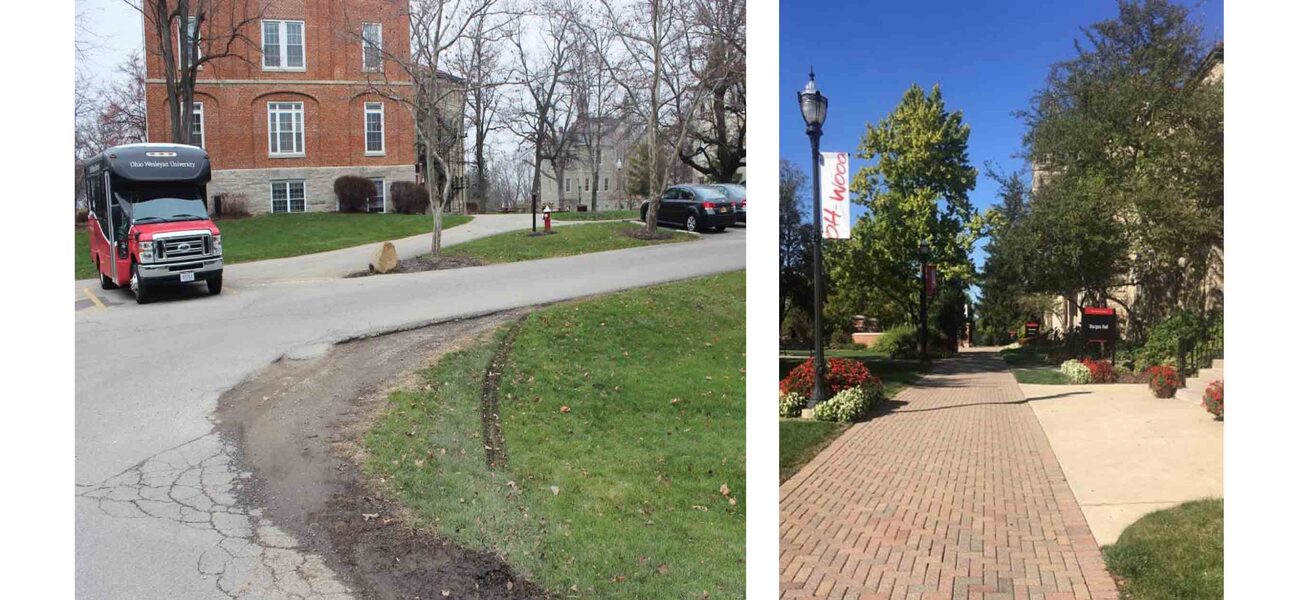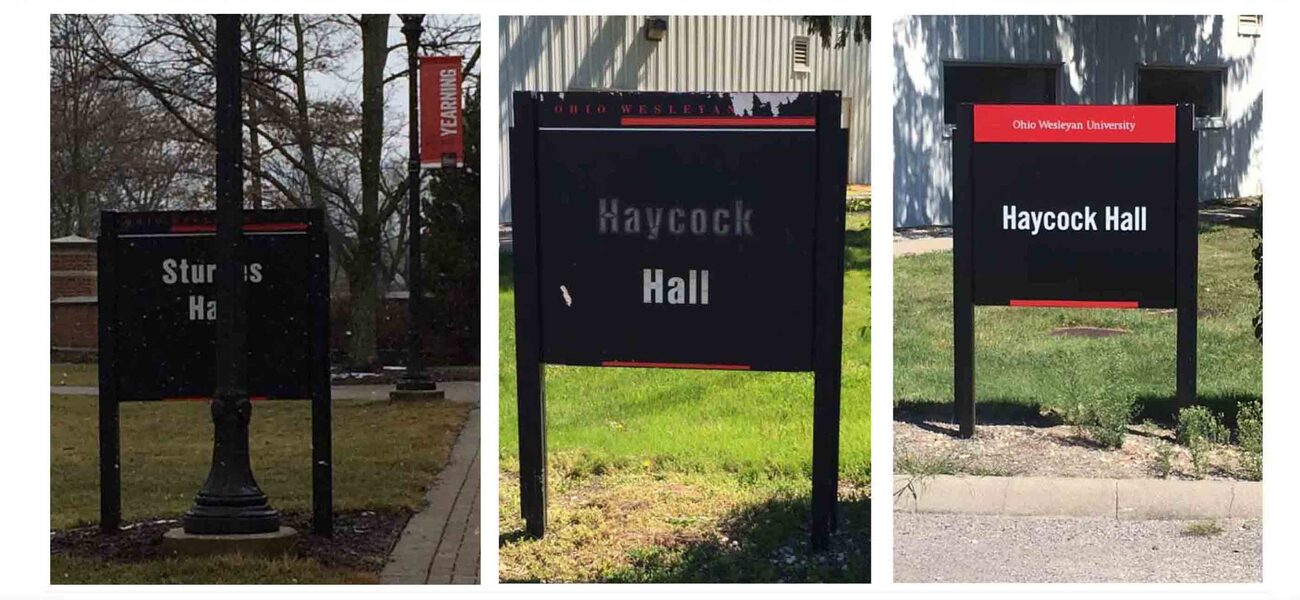Higher education facilities executives are rightly focused on the needs of students, faculty, and administrators, but what about prospective students and their parents? Targeting facility and campus improvements to boost the campus tour experience has a positive impact on recruitment, enrollment, and retention. A formal evaluation process—resulting in a detailed scorecard and a set of recommendations presented in the form of a prioritization matrix—might enhance the all-important first impressions and intangibles that are impossible to quantify.
Erik Kocher, design principal at Hastings+Chivetta Architects, says the campus tour is so important that he brings an office intern and covertly joins a campus tour posing as a parent and prospective student prior to every design and architectural project, even campus master plans. “You can learn so many things from your guide, but you also get a quick understanding of the institution itself,” he says.
Having a fresh set of eyes analyze the tour from beginning to end can reveal a laundry list of possible facilities improvements—some low-cost/no-cost and some with a hefty price tag. As part of his firm’s Architecture of Enrollment Management service, Kocher compiles those recommendations into a matrix that helps institutions get the most impact from their available facilities budgets. For example, adding clear signage directing visitors to the admissions office, or doing some basic landscaping around the building, are low-cost improvements. Renovating the admissions building would be a high-cost, high-priority investment. The recommendations also include considerations like making sure the career center is included in the tour, or emphasizing campus efforts toward sustainability. For example, Kocher says that students touring the University of Kentucky see a dashboard of energy usage displayed at several of the buildings.
Getting There
The Hastings+Chivetta evaluation starts even before the prospective student arrives on campus. Kocher says it’s important for institutions to make the online signup and planning process as smooth as possible. One commonly overlooked detail is providing clear directions to the admissions office. Standard GPS might take a family through an unpleasant part of town because it’s the shortest route. Providing better directions in an app that parents can download onto their phone is important. “Students today expect to be able to take a virtual tour prior to actually pounding the pavement, so creating a video can also be helpful,” adds Chris Chivetta, president of Hastings+Chivetta.
“Post-tour surveys reveal that some people make up their mind before even getting out of the car,” says Kocher, so that first 15 minutes on campus is critical. Institutions need to pay close attention to signage, designated parking spaces for visitors, and handicapped parking. One nice touch is having signboards inside the admissions building welcoming visitors by name. People may have flown in or driven a long distance to the campus, so refreshments and restrooms are important. The admissions office should have plenty of comfortable seating, interview rooms, and easily accessible power outlets for parents to sit down and open up their laptop. There should also be plenty of brochures and written material for both the institution and regional tourist attractions.
Best Foot Forward
The tour itself is the heart of the experience. Again, facilities managers need to take a fresh look at the quality and overall connectivity of campus roads and pathways, creating unified signage across campus, and sprucing up the landscaping. Tours need to emphasize new buildings and modern classrooms. And tour guides need to go beyond academics and discuss food choices, housing options, the availability of maker spaces, the types of clubs on campus, and campus traditions.
Chris Chivetta recalls taking his daughter on a campus tour at the University of Tulsa; this after he had been the campus architect there for 15 years. “Due to campus construction, we went down the only path that we hadn’t replaced in the campus master plan. We went to the only residence hall room that hadn’t been renovated, and when we got to all of the new buildings, the tour guide said, ‘Over there are two new engineering buildings, we renovated the student center, there is the performing arts center, and the new soccer stadium is over there. If you want to see those, you can walk over after the formal tour.’” Chivetta immediately wrote a note to the University president and vice president of facilities, and the whole tour was quickly revised.
For another client, he was interviewing for a campus master plan project and was given a tour by the college president. At the end of the tour, he was asked for the first thing he would do if he got the job. Chivetta replied that he would power wash the admissions building because it had mold on the front steps and façade. That low-cost recommendation got Chivetta hired. In both cases, a fresh set of eyes made all the difference.
Ohio Wesleyan University Makes Huge Strides
Ohio Wesleyan is a small, 175-year-old liberal arts college in the central Ohio city of Delaware. The campus is spread across 200 acres adjacent to downtown Delaware, with around 60 buildings and 1.5 million sf under roof. “Like most schools our size, we have a lot of deferred maintenance, and we have some challenges in finding ways to fund it,” says Peter Schantz, physical plant director.
Kocher’s assessment of the Ohio Wesleyan campus tour demonstrates that institutions can make major improvements to the tour experience without spending a great deal of money. Their total investment thus far is an estimated $1.5 million.
Pulling up to the admissions building, Kocher spotted a wall in disrepair and a rutted, poorly lit parking lot. The campus map was out of date and hard to read. The admissions building itself was a beautiful, historic structure, but it was not handicapped accessible. His first impression of the interior was, “This looks like my grandmother’s living room.” Instead of an appealing display of snacks, visitors were offered water bottles out of a mini-fridge.
On the plus side, the tour was highly organized, and at one point everyone was picked up by a van and taken to another area of the spread-out campus, which was a unique feature. The van also took visitors past downtown Delaware, demonstrating the school’s proximity and connectedness to the community.
The tour visited a science building that featured an impressive atrium, but there were cracked tiles and dirty walls. A classroom included in the tour had no windows, clutter in a corner, and an old blackboard on the wall. Re-directing the tour to a more modern and appealing classroom was a zero-cost solution. The tour then went out the back of the building, where the steps were cracked and the sidewalk was in bad shape. The next stop was a dorm room that was one of the worst on campus, which generated an interesting post-tour discussion with school officials. The housing office representatives said they specifically offered up that room to the tour because it was the only unoccupied room available. They were initially reluctant to give up a more desirable room to the tour, but eventually agreed.
Many of the improvements fall into the obvious category and are simpler to address: Better lighting, better signs, fixing parking lots and sidewalks, and landscaping. Others demonstrate more creativity. For example, an outdoor area in the center of campus featuring fixed seating was rarely used. Schantz tore out all of the seats and created a flexible, common area that has become a popular gathering spot.
He also took advantage of an on-going investment in new, underground steam pipes, to include money in the budget for surface improvements to sidewalks. Renovations to outdated tennis courts were not in the budget, so the University put up a visual screen to hide them from campus tours. “You wouldn’t even know they are there,” says Schantz. More recently, he was able to secure $300,000 to renovate the welcome center of the admissions building.
When Kocher conducted his tour evaluation in late 2015, Ohio Wesleyan scored a 56 out of 125, one of the lowest scores he had ever recorded. As a result of Hastings+Chivetta’s study, Schantz has spent the past two years implementing 50 of the 60 recommendations that Kocher provided, starting with the simple items and moving up to the more ambitious projects. “We went back this spring and we have re-scored the campus based on the very same data, and Ohio Wesleyan is now the second-highest-ranked campus in our database,” says Kocher.
Kocher is currently compiling the statistics and says the anecdotal evidence from exit interviews with students and parents indicates that improving the tour experience is certainly worth the effort.
By Neal Weinberg


